What is Run and Jump Man Press?
A team can at any point extend their man to man defense up the court into a full court press. This type of press is keeping straight man to man principals but guarding the entire length of the floor. This is a good option for teams who are quick, deep, and can guard 1 on 1. What about teams who are looking to create turnovers in the press without wanting to change into a zone press? That is where the Run and Jump Man Press can be used.
The Run and Jump Man Press keeps every defender guarding man to man. It extends the man-to-man defense into a full court scenario. The difference is the Run and Jump Man Press has the defense looking for opportunities to rush the ball and create a trap in the man press. This type of rushing, trapping defense creates a hectic and chaotic game where the defense should be running around all over the place trying to get deflections and steals.
The Run and Jump Man Press is the definition of organized chaos with the emphasis on the chaos. The defense will start with certain matchups but once the first defender rushes towards the ball to trap, the defense is going to likely remain in a scramble mode throughout the possession. When a defense is in scramble mode, the players will likely be guarding somebody totally different than their original matchup due to the rotation needed for the defense to work. The chaos created in the rotations makes some coaches move away from using this kind of press because any structure of defense will be lost.
The way the run and jump man press works is the on the ball defender creates pressure at the point of attack. As soon as the offensive ball handler looks down at their defender, the next defender who is one pass away will rush the ball and try to trap. As the 2nd defender leaves for the trap, the next closest defender rotates up to the offensive player who was just left by the 2nd defender. The 4th defender rotates up to the offensive player left by the rotating 3rd defender. That leaves the last defender guarding the farthest two offensive players away from the ball.
This press works well when run correctly but it is difficult to run well because all the defenders must be moving at the same time. The 2nd defender rotating up to trap reads the ball handler to know when to go and trap. The 3rd and 4th defender are watching the 2nd defender to time their rotations to be in sync with the 2nd defender leaving to trap. That means all 3 defenders have to be moving at almost the exact same moment. This type of basketball IQ and team togetherness is hard to develop.
If one defender does not leave in unison with their teammates, then the offense has an easier pass out of the trap. So, the 2nd defender is watching the ball and their man. The 3rd and 4th defenders are watching the ball, their man, and the 2nd defender. All 3 players have to take in a lot of information quickly and be able to make the right decisions for the press to work.
Once a pass is made out of the trap, then the defense can either fall all the way back to half-court defense or they can look to keep chasing the ball and rotating behind the ball as the offense keeps making passes. So, this press can be a one pass and retreat press, or it can be a style of play that is used throughout the whole game.
The other decision a team has to make is how to rush the ball. The rush can either come from the front side where the ball handler can see the defender coming up to trap. Or the rush can come from the backside where the ball handler will not see the trap coming. Either way will work but each has their own set of pros and cons which I will discuss in the trapping portion of this guide later.
Advantages of the Run and Jump Man Press
1) Creates a Very High Tempo
The Run and Jump Man Press is going to be ultra-aggressive in rushing the ball looking to trap. This aggressive style of defense is going make the tempo of the game very high. The defense could be looking to trap early and often. The press can be used either after an offensive make or miss. So, the opponent is going to be on high alert the entire game.
The defense is going to pressure the ball and trap the offense with the run and jump style. This is going to make the offense in turn have to play fast or they will end up in traps. So, the offense will have to play quickly to avoid any traps.
The offense could break the press and set their offense back out front in the half-court. However, the defense can continue to run and jump even in the half-court meaning the offense has no option but to try and score with the defense chasing them around the court. The run and jump man press forces the opponent to play fast or be under constant pressure.
2) Keeps Man to Man Principals within a Pressing Defense
One of the hardest things to do as a basketball coach is to get all the players to understand the concepts of a particular offense or defense. Each new offense or defense comes with its own set of rules. High school players can start to play slow if they are thinking about how to play a certain offense or defense. Players should be reacting and not thinking. A team with a lot of offensive plays and/or defenses can make players think about what they are supposed to be doing rather than just reacting to each situation.
The Run and Jump Man Press keeps all the basic 1 on 1 man to man defensive principals in place while adding some additional rotations. This helps players because they are learning 1 or 2 adjustments to a defense instead of an entirely new defense. Once a player understands man to man defense, the run and jump press takes that understanding and extends it to the entire floor.
I always try to keep things simple. I coach man to man half-court defense as a primary defense. The run and jump press do not change the rules of man-to-man defense. It does not add a completely new rotational pattern like a zone defense would. The run and jump man press simply adds a couple of new rules to the half-court man to man defense. This helps to keep the defense simple for the players.
3) Can be Modify for each opponent and each point guard
The Run and Jump Press is able to be adjusted very easily. An opponent with a really good point guard can have the defense either jump early to get them to pass the ball or not jump at all to keep that defender in a position of help if the on the ball defender gets beat.
An opponent with bad guards can have the defense adjust to be more aggressive by trapping early and often. The thought is that more pressure will result in more turnovers, so the defense wants to trap to keep maximum pressure on those guards at all times.
Will the defense jump from ballside or backside? Depending on the opponent and their guards, it might be better to hide the trap coming or it might be better to let the guards see the jump coming. Does the defense make 1 defender the person to always jump the ball or does the positioning of the offense dictate who jumps?
The Run and Jump Man Press is not a press set in stone as to how, why or when to run and jump the ball. This flexibility gives the defense the benefit of being adjustable to each opponent. This also gives the press the chance to change how it is being used throughout the game. A team could have 4 different jumping techniques used for each quarter of the game.
For instance, one quarter may be early jumps. The next quarter will be jumping from the frontside. The 3rd quarter could be jumping from the backside. And the 4th quarter could be jumping when the point guard is going to their left only.
The Run and Jump Man Press can be used many different ways to keep the offense off-balance. The ability of a defense to keep pressure on the offense but do it in many different ways can be mentally taxing for an opponent. Mental fatigue can lead to mistakes happening. So, the run and jump press can wear an opponent down both mentally and physically.
Disadvantages of the Run and Jump Man Press
1) It is Chaotic
The Run and Jump Man Press is problematic at times due to the nature of the press. There are a couple of principles for the players to follow. After those principles, the players are pretty much free to run around looking to trap the ball at any time. This freedom of movement causes the press to have less structure in comparison to other zone presses.
The greatness of the press is the same reason for the weakness of the press. When players are moving in unison and with purpose, the chaotic nature of the press benefits the defense. When players are not moving together and without purpose, the offense can usually get an easy shot at the end of the press.
The run and jump style want the game moving at a frenetic pace. The pace should benefit the defense by causing the offense to make decisions faster than they want too. The only way to reduce decision making time is by causing chaos within the game itself.
Some coaches do not like this press because it takes away the importance of the coach during the game. When the run and jump man press is being ran correctly, the coach does not have the time to coach and adjust players during the play of the game. If the players are waiting to hear instructions from the coach, then they are playing too slow. The players should be reading and reacting to play at the pace needed during the game.
The coach has a reduced role during the game with this press defense, but they are really important during practice. In order for the press to be effective, the players need to understand what they are doing in the press as the play is happening. Practice reps and drills in practice get the players to understand what they are seeing and doing becomes very important. Coaches have to have players ready to play this style before the game starts and not during. An inability to coach during the game will only fuel the chaotic nature of the press even farther.
2) Matchups will be lost
The Run and Jump Man Press has the defense looking to rush the ball and trap. The defenders behind the rush will rotate up. When the offense passes the ball out of the rushing trap, a defender should be close to the player catching the pass. With the defense rotating, the defender now guarding the ball was not the original defender of that offensive player.
The number of rotations and scrambling done by the defense means the defensive matchups are only going to be in place during the initial setup of the press. Once the offense starts dribbling and passing, the defense is going to react to the ball moving. As the run and jump takes place, the defense will rotate up a man meaning almost all matchups have been changed.
The matchups constantly being changed due to the run and jump style means the defensive players must be able to guard all 5 players on offense. A team with a big and slow center is going to struggle using this press because they will need to guard the other team’s guards at times. If they cannot, then the press will not work.
The Run and Jump Man Press works best with a team that has all 5 players very similar. The ability of the defense to interchange their players makes the press more effective. But the defense is not going to be able to have each defender on a certain offensive player. The matchups will change each possession. So, there is a chance a defender will be guarding a new offensive player on each possession. This is problematic if the best offensive player is constantly being guarded by a bad defender.
3) Every defender has to move together
Unlike other zone presses where the ball dictates rotations and traps, the run and jump man press can rush and trap at any point in time. This makes it difficult for every defender to stay together. Each defender must keep an eye on the ball and an eye on the person rushing to trap. As soon as the rush happens, the other defenders must rotate immediately.
Any defender who does not rotate and is not moving with their teammates will give the offense an opening to make a pass and beat the press. It is hard to get 3 players to work together on the court. The press may work with just 3 players working together. But the offense will still have a close pass to beat the initial trap.
Four defenders working together is good but still leaves a skip pass in most cases open for the offense. When all five defenders are working together and moving in unison, then the offense should only be left with a potential long diagonal pass that is very hard to make with no defense. This pass with a trap on the ball will normally end up in the hands of a defender or in the stands.
A defender who does not see the rush or is slow rotating causes the press to not work correctly. Add in the rush can occur by multiple defenders at multiple times makes the ability of the players to stay together in their movements all the more challenging. When done correctly the press is very effective. The problem is getting the movements to all occur together because that is hard to do.
Positions of Run and Jump Man Press
The positions of a Run and Jump Man Press are not really needed. The press starts in a man-to-man defense. When the first rush comes then the defense is rotating up and towards the ball for as long as the press is trying to trap. Depending on how the offense sets up and how the ball is being passed and dribbled, the defense will change as the offense changes. Each possession has the potential for a different defensive alignment and a different defender rushing the ball. This makes the Run and Jump Man Press almost position less.
Trapping in the Run and Jump Man Press
Trapping in the Run and Jump Man Press has a few different options. The rush can come early, middle, or late. The rush can come from the frontside or the backside. The choice of when and how to trap makes the press harder to scout and prepare for because defenses can keep changing the when and how to make the press break different.
An early trap is when the rush comes either on the catch of the inbounds pass or after the first couple of dribbles. The defense is rushing the ball immediately making the press be really aggressive.
A middle trap is rushing the ball when the dribbler gets a step or two beyond the 3-point line. The dribbler is short of the mid court line but has dribbled probably around five times or more.
A late trap is looking to trap the ball as soon as it crosses the half-court line. This will bring in the half-court line to act as another defender reducing the amount of space the offense has to use.
An early trap is the most aggressive. The middle trap has the chance of causing a 10-second count and turnover. The late trap can cause turnovers by reducing the amount of floor the defense has to cover. There is not a best choice in this. A team could rush early in the 1st quarter to get the tempo and aggressiveness up. Then rush in the middle during the 2nd and 3rd quarters. The defense could rush late in the 4th quarter. All 3 rushes can and do work.
Trapping can also be done from the front side or back side. Front side is rushing the ball with next defender right in front of the ball handler. The defender leaves their man and rushes the ball as it is being dribbled at them. A back side rush is when the next defender is coming from backside usually out of the vision of the ball handler. This rush has the on the ball defender cut off the forward dribble right as the back rush gets to the ball. This is harder to execute with the timing needed but is much more effective when done correctly than the front side rush.
The other key item is the rotations by the other 3 defenders. A front side rush has the 3 defenders rotating to the ball. A back side rush will have the defenders running away from the direction the ball is being dribbled. The key to rotating properly is having all the defenders moving together on the rush.
Because the press starts as a man-to-man defense, it will change with how the offense is set up. There is no way to know beforehand how the offense is going to react and position themselves with a man-to-man press. In the diagrams below, I have shown a few different possible setups for the offense, but the positioning of the offense determines what defender rushes the ball and how the other 3 defenders are rotating behind the ball.
Trapping from the Front
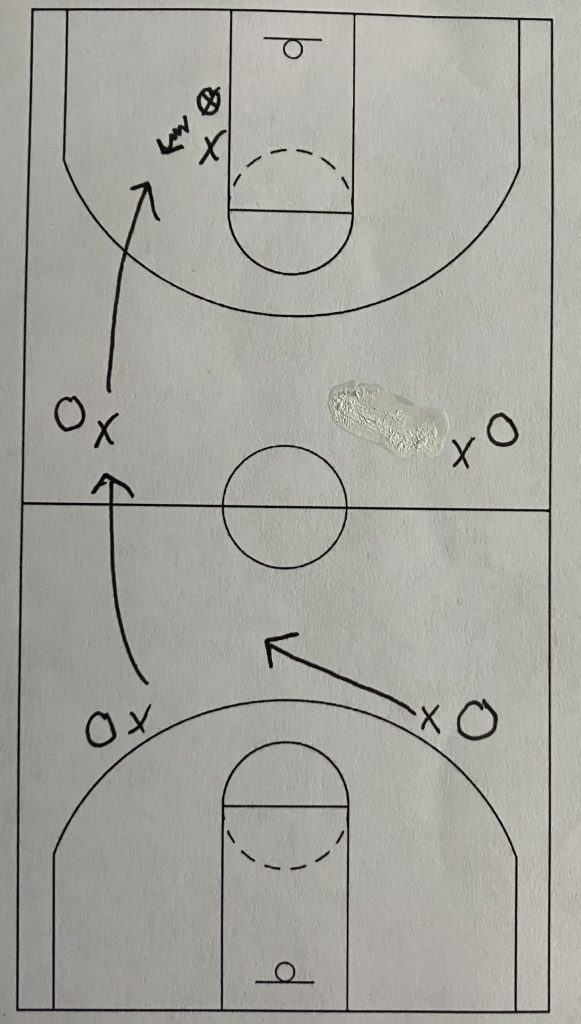
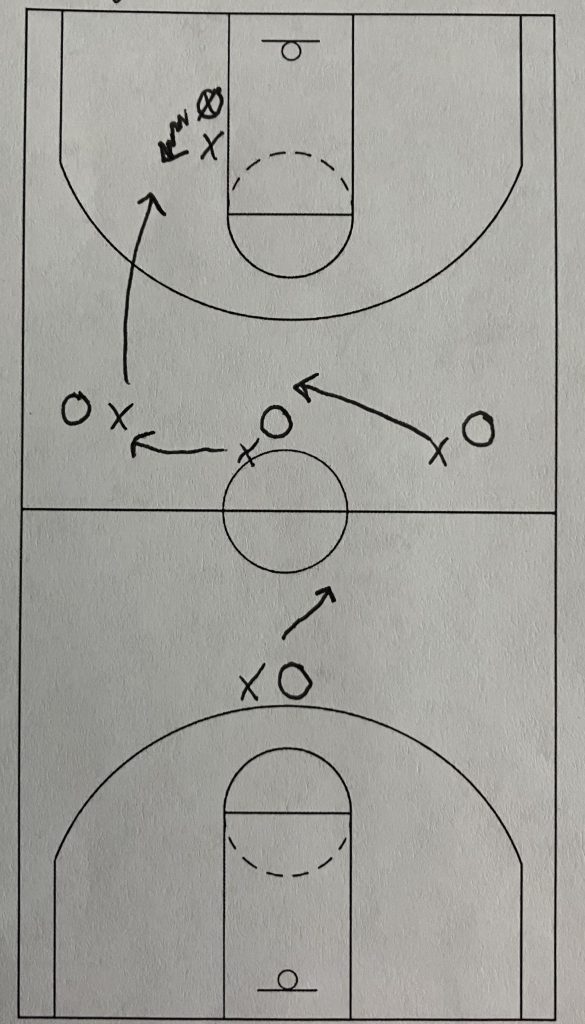
In the diagrams above, I am showing an early trap scenario. The difference between early, middle and late is not that much. I am also showing multiple offensive press setups. Without knowing how the offense is going to be setting up, a true rotational defense is impossible to provide. The rotations are completely dependent on the offensive setup. However, there are three rules to follow.
- When trapping from the front, the next defender closest to the ball will rush the ball trying to get the trap.
- Every other defender will rotate towards the rusher.
- The last defender will cover the two offensive players farthest away from the ball.
In the above picture on the left, the offense is using a 1-2-2 press offense. The next defender rushes the ball for a trap. The back left defender sprints up to the offensive player who was just left open. The back right defender rotates to the middle. The two farthest offensive players are the two around the offensive 3-point line. This means the back right defender who is the farthest defender away from the ball is covering those two offensive players. The defender is looking for a long skip pass to steal.
In the above picture on the right, the offense is setup in a 1-3-1 press offense. The left defender is closest to the ball and rushes. The middle and right defenders sprint to the offensive players to their left. The right offensive player and back offensive players are farthest away from the ball. This means the back defender being farthest away from the ball is trying to split the difference between these two players.
The last defender has to cover two offensive players. A direct pass to either of those two players will normally be a long high skip pass. This type of pass should give the defense enough time to rotate back without giving up an easy layup.
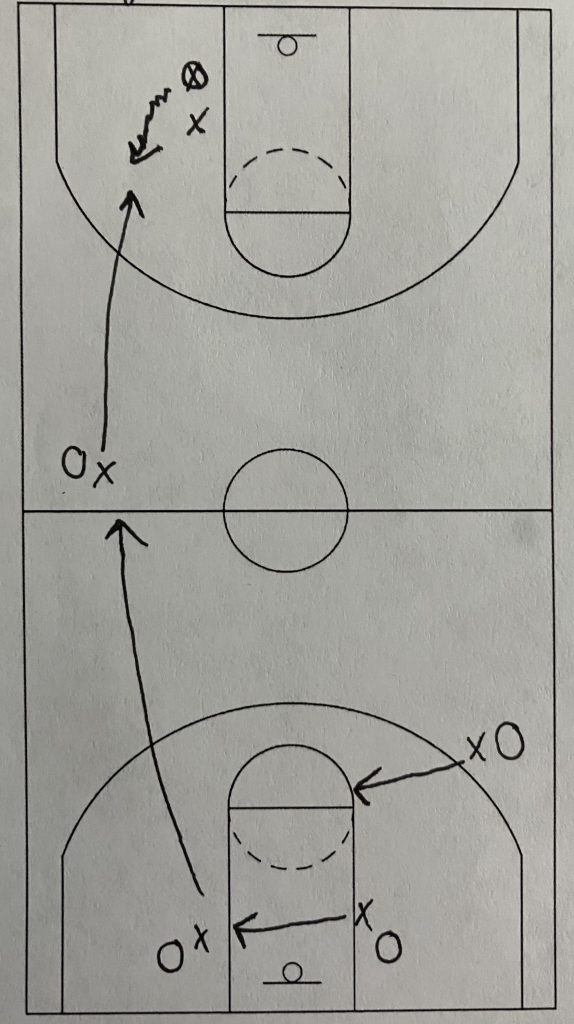
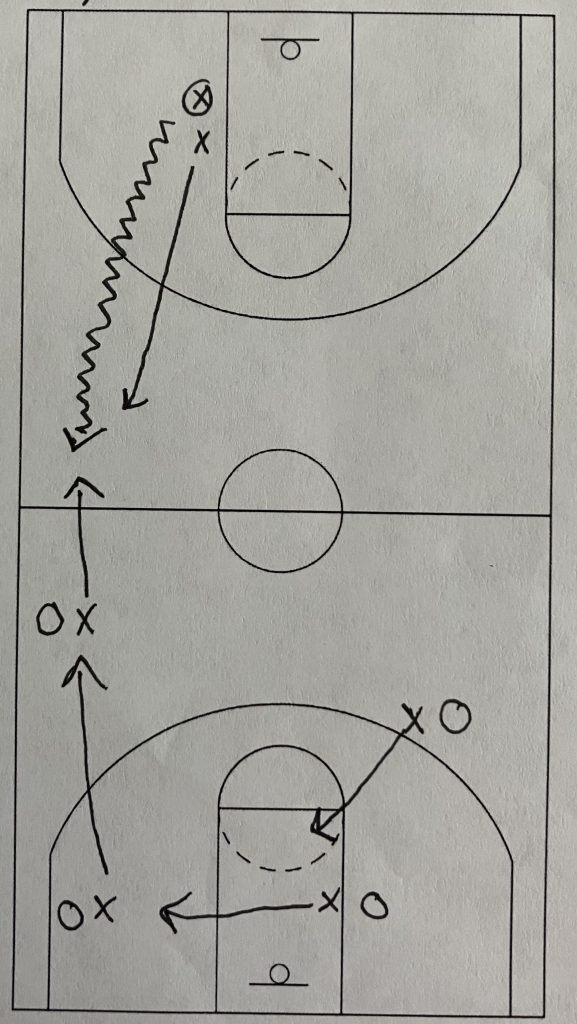
The above diagram on the left, has the offense clear out the court to let the point bring the ball up by themselves. The 2nd defender rushes the ball. This is where the players must make a judgement call.
The two defenders on the right have to decide which two offensive players are farthest away. Or they have to react to one of the offensive players running towards the ball. However it works, one of the right defenders will deny one offensive player while the other defender is splitting the other two offensive players.
Again, the players need to be coached well in practice so they can adjust in the game without the coach having to tell them what to do. This scenario is why. The players have to make the decision on who has to split and who has to guard one. And the decision may change if one of the offensive players runs towards the ball. As they run up to the ball, the two defenders have to see it and react with one going up with the offensive player and the other defender now adjusting to split the last two offensive players.
In the diagram on the right, the trap is coming late. The later the rush happens, the less court there is to guard. So, it is basically the same setup as the left diagram, but the rush is coming middle to late. The 2nd defender rushes. The left defender runs up the sideline to stop the closest pass available. The right block defender rotates towards the ball. The right wing defender drops and is guarding the two offensive players on the right side of the court.
If the right offensive wing runs towards the ball, then the right wing defender will stay with them and the back defender is now splitting the difference between the two offensive players on the baseline.
The real issue with rushing from the front is the point guard is going to see the trap coming. By seeing the trap coming, they have more time to decide what to do before they are trapped. A good point guard will calmly back dribble and stay out of the trap until they can make a pass. However, against an inexperience point guard or a panicked point guard, seeing the trap coming could cause them to do something wrong.
I like rushing from the front in JV or younger. Most point guards at these levels are going to speed up instead of slow down. When a player speeds up, mistakes happen. When a player slows down, they stay calm and usually make the right play.
Trapping From the Back
Trapping from the back requires the rusher and on the ball defender to be very connected. The on the ball defender will force the ball to the sideline and then cut it off right as the rusher is there for the trap. The on the ball defender must be able to cut the ball off at exactly the right moment. This is hard to do.
The great benefit to this rush is the point guard will not see the trap coming until they are in the trap. By the time they realize what is happening it is too late. I like using this rush at the varsity because most teams have a point guard who will make the right decisions when they see a trap coming.
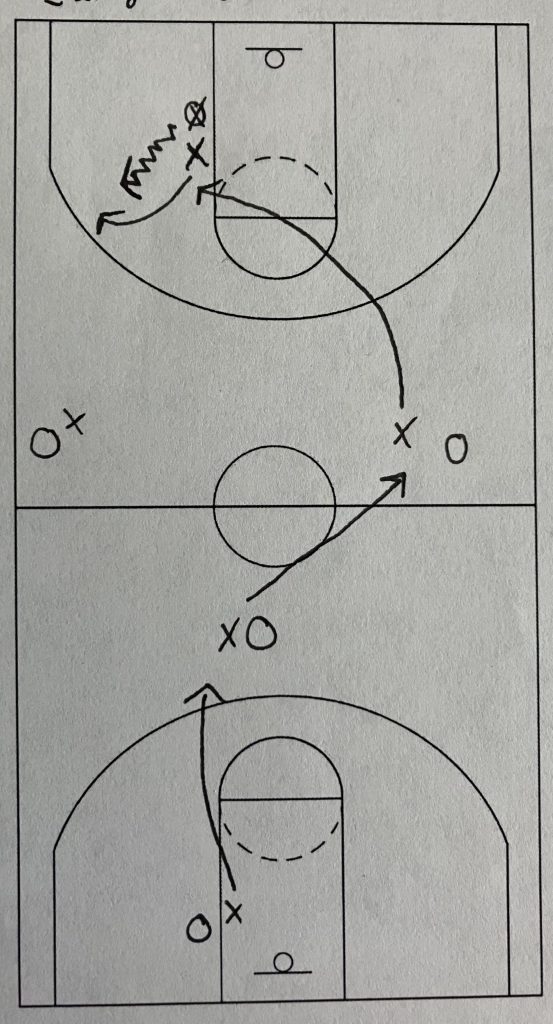
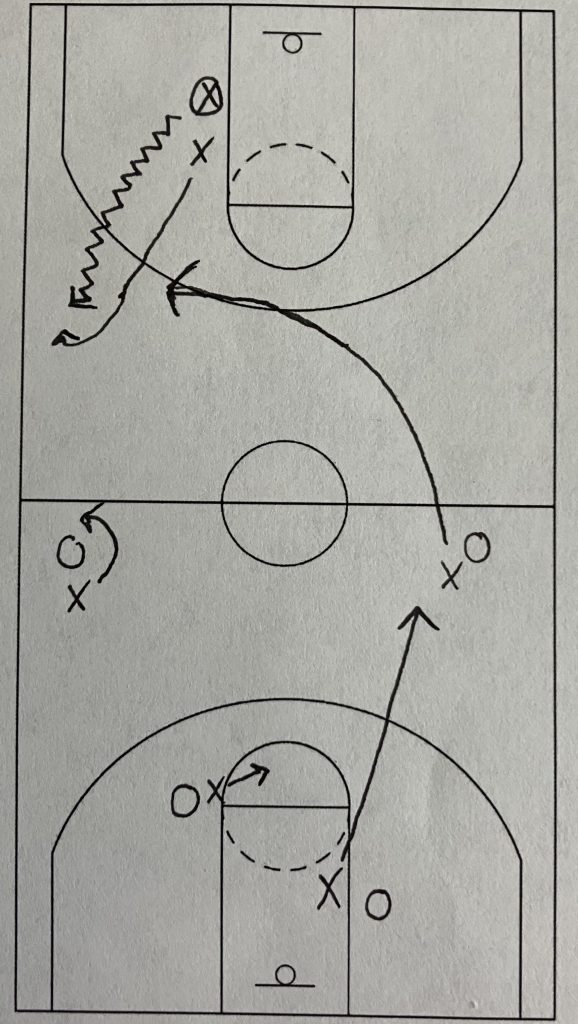
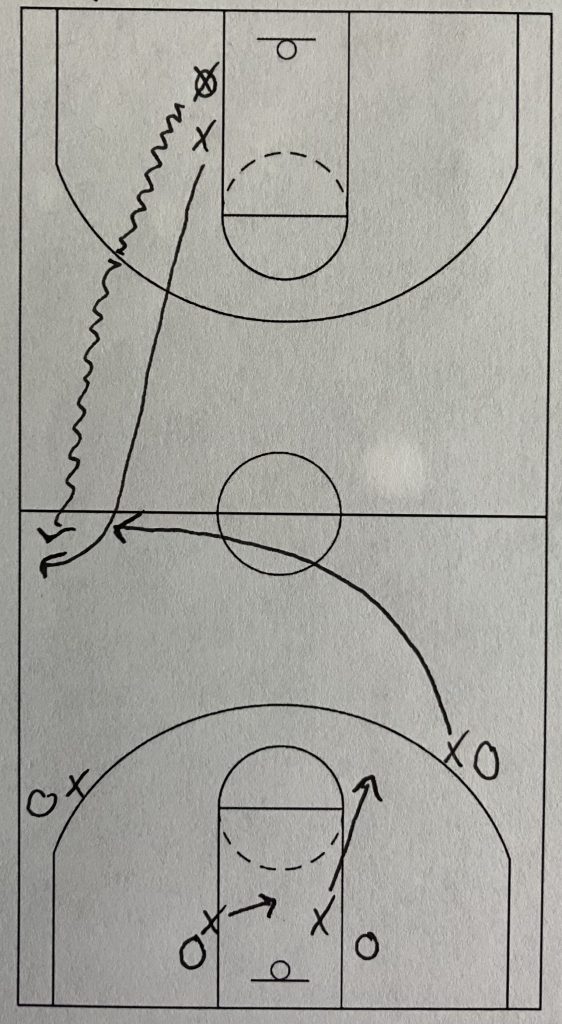
In the diagrams above, I have an early, middle and late rush. I also have different offensive setups. By rushing from the backside, the other 3 defenders will be rotating away from where the ball is being dribbled. The back rush will also keep the defender closest to the ball next to their offensive player preventing the easiest pass available to the point guard.
The defense is trying to sneak up on the point guard and trap before the point guard realizes a trap is coming. The on the ball defender is trying to put a lot of pressure on the ball to keep the point guard focused on them. The next defender in front of the point guard is not moving so they are not sensing a trap is coming. Then the backside defender is there without the point guard ever noticing they have left their man.
In an early rush, the defense wants the trap as soon as possible. The defender is leaving on the first dribble. The rotations are going to leave the long passes open. The last defender has to try and position themselves, so they are able to steal either pass. If this last defender comes up too far, then an offensive player can be wide open right at the basket. If the defender does not come up far enough, then a skip pass to the middle offensive player can be made and a possible 2 on 1 is there for the offense to attack.
The early rush has the most floor for the defense to cover and gives the offense a lot of room to move and pass. The early rush is mainly used at the end of games when a defense has to force the issue of the game and is trying anything to get pressure on the ball and steals on bad passes. A good offense should not struggle with the early rush. The offense will have too much time before the trap arrives to make the right decision with the ball.
The middle rush is my personal preference. The point guard has started to dribble up the floor but has not gotten close to half-court. The backside defender will be leaving when the ball crosses around the top of the 3-point line. This is the spot when the offense relaxes because the press has not trapped yet so the other offensive players outside of the point guard have cleared down the floor. As the offense starts to clear, the defense sends the rush. If the offense does not respond to the rush, then the defense can get a trap with no other offensive player anywhere near the ball.
The rotations are shorter to make. The defense has a chance to recover if a pass is made before the trap gets there or after the trap is set. The drawback to the middle rush is the offense still has plenty of room to move and the point guard still can use a back dribble to escape the pressure and trap. But when executed correctly the middle rush gives the defense a great chance for a steal.
The late rush has the highest chance for success. If the rush is not successful, then the offense will normally get a wide-open shot. The late rush reduces the floor to the absolutely minimum it can. The rotations are much easier. The offense cannot retreat because the half-court line is being used as an additional defender. When the defense sets a good trap using the late rush, the offense will struggle to escape without a turnover.
The problem with the late rush is the offense is still close to the ball. So, the offense will still be in a position to receive a pass out of the trap. Add in the 2 defenders trapping the ball and the other 3 rotating behind that trap, the defense will struggle to recover on any pass made out of the trap. The offense will have players in good scoring positions already and a defense that will be scrambling to closeout to them.
Personnel Needed for the Run and Jump Man Press
There is not a certain personnel grouping needed to play a run and jump man press. Any team can use it. However, I like running the press with a guard heavy team. A team that has similar players in all 5 positions are in a better spot to succeed with the press. Matchups are constantly changing. A center could become a liability after the first rotation if they happen to get stuck guarding a quick guard.
A team that has 5 players who are all perimeter players makes it easier to run because all the matchups are going to be the same no matter which player is matched up to the offensive player. When all the defenders are basically the same, it does not matter which defender gets matched up to which offensive player. Any team can run the press, but it is best used with personnel groupings full of perimeter players.
Keys to the Run and Jump Man Press
1) Embrace the Chaos
The Run and Jump Man Press should be chaotic. The defense will be rushing the ball and rotating behind the rush. They will be switching who they are guarding sometimes multiple times in the same possession.
It is different than other zone presses in that the rotations are happening on defensive player movement and not on ball positioning. This means there will be possessions when players rotate too early or too late. Mistakes will be made. Those mistakes must be made going 100% and 110 mph.
A coach has to give up their control of the game when using the run and jump man press. This scares some coaches so this press will never be used by them. The only way a coach can use the press effectively is by embracing the chaos it is going to bring. Defenses are going to give up open shots and some easy layups.
The success of the defense comes in speeding up the opponent and getting some steals. There will be possessions where the offense wins. If the offense is forced to play faster than normal, then the press is being successful even when the offense wins the possession. The chaos the press can cause could take some time before working.
The physical and mental ability of the opponent to handle the run and jump press can decrease the longer the press is being used. Opponents can become tired if they are not used to playing at a high tempo. Opposing players can mentally fatigue because they never have a chance to relax and that leads to mental mistakes. All of this occurs only with the chaos the press brings. Embrace the chaos.
2) Move Together
This is the key that will make the run and jump man press work or not. The five defensive players must learn to watch each other and move and react with each other. There is never a time when a single defensive player is moving without a teammate moving as well. This is the hardest part to learn about the press.
When installing the run and jump man press, I will use drills to get the players to learn how to watch their man, the ball and their next teammate. Each defender has a teammate that they have to react with except the initial rush defender. It can be hard for players to learn to watch 3 different things, but it is necessary for the press to work.
I will add a page with the drill that I use in detail. I will describe it here. It starts with a 2v2 scenario. The off the ball defender just rushes the ball and traps. Then I move to a 3v3 where the rush occurs, and the 3rd defender replaces the rusher. Then I go to a 4v4 where one defender stays, one defender rushes and one defender replaces. This is usually a diamond setup where I will work on rushing from both the front and the back. Then I will add the final piece of 5v5 where it is a scrimmage setting and I am stopping and correcting mistakes. All of this is done before I ever try to run it in a game.
A lack of connectedness leaves openings in the press. These openings give the offense great chances to pass the ball and attack the defense. The defenders moving together make the offense look for a different teammate than the one that is initially open. And if the offense still wants to pass to the offensive player the rush defender just left, then it should be an easy steal for the defense.
3) Players Must Be Decisive
The only way for the run and jump man press to work is for the players to be decisive in their decision making. The drills in practice are needed for the players to learn what to see and when to react. Once the game starts, the players must be comfortable and relaxed to run the press. They cannot second guess themselves. Any hesitation will cause players to play slow which helps the offense.
The players have to understand mistakes are going to happen at times. The players must play at a high tempo whether they are making good plays or bad mistakes. The players also must not be worried about getting subbed out of the game when they make a mistake. Mistakes will be made, but players should not be punished if they are playing fast and decisive. Indecision and slow play must be dealt with immediately.
Once players understand that they will be subbed out when playing slow or being indecisive and not when making mistakes, the tempo will pick up even more. The players will stop thinking about what to do and just react to what they are seeing.
Correcting mistakes must be done in film study or the practice court. Once the game starts, then players should stop thinking about what to do and react to what they are seeing based on the drills done in practice. Up-tempo and fast play will help to enhance the chaos created by the run and jump press style.
Along with the speed, since players are all moving together any indecision by one player affects all of the other players. Once a player starts to rush or rotate, the teammate behind them reacts as well. If a player starts to rush and then stops midway, then the next rotational defender will be stuck in between two offensive players as well.
The players behind the front defenders depend on those front defenders to react at the right point of time. The back defenders react to the movement of the front defenders. If the front defenders are jab stepping because they start to go and then stop, then the back defenders are unsure of if they should go or stay as well. All decisions and movements must be made with 100% conviction because every other teammate is moving with that decision too.
Youth Basketball and the Run and Jump Man Press
The run and jump man press is something that can be ran at the youth level. The major difference between the youth level and high school level is the number of players moving with the rush. At the high school level, there needs to be at least 3, but probably all 5 players to be moving on the rush for the press to work. At the youth level, the press may work with only 2 players moving. These two players being the on the ball defender and the rush defender.
The skill level of the youth teams reduces the number of players needed to get turnovers. A good on the ball defender, rush defender, and 1 other defender rotating up to take away the closest pass should cause a lot of issues for an opponent. As the players get older and more skilled, the additional 4th and 5th defenders will need to rotate as well for the press to work.
This will be a press I would look to use at the youth level because I can reduce the number of players needed to run it down to 3 instead of a zone press needing all 5. I can keep man to man defense as the defense while using the press. With the reduced number of players involved, the coach can tell when the rush defender needs to go so the hardest part of the press is done by the coach and not the players. This keeps the players playing and not thinking. It keeps everything very simple for youth players.
Conclusion
A smaller, quicker team should have this press ready to go at any moment. A guard-orientated team can use this press as well. When done correctly, it creates all kinds of problems for the offense. The hardest part for me is trusting the drill work in practice enough to let the players have the freedom necessary to use the press in a game. It can be hard to use the run and jump man press at first because it can break down so easy. The growing pains are a serious hurdle.
However, once those early mistakes are corrected the benefits of the press are great. The physical conditioning needed to play at that high of a tempo is something opposing teams will struggle with due to not playing or practicing at that kind of a tempo. Fatigue normally makes players make mistakes.
The mental fatigue can also wear an opponent down. The ability to change when and where the trap is taking place puts the opponent on edge at all times. They never have a chance to relax during the game. When players are always on alert, they will wear down quicker.
The benefits of the run and jump man press far outweigh the risks. But it can be riskier at the beginning of learning the press when the players are not comfortable with the press. This is a press that will take time not only in games but in practice to get the players fully understanding and executing at a high level. This is a press that might get overlooked at times but with the right team, it can be the best press to use.

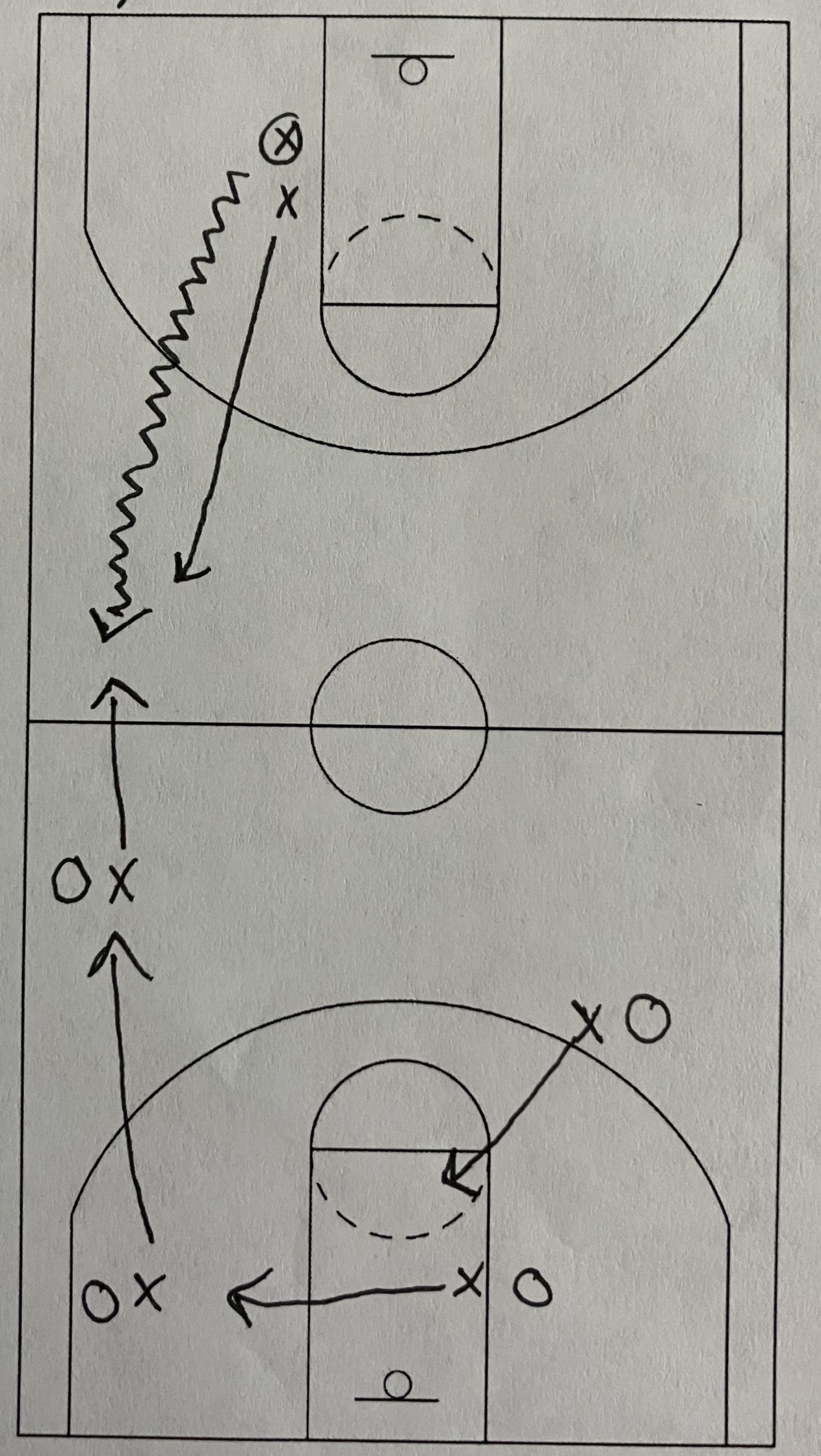
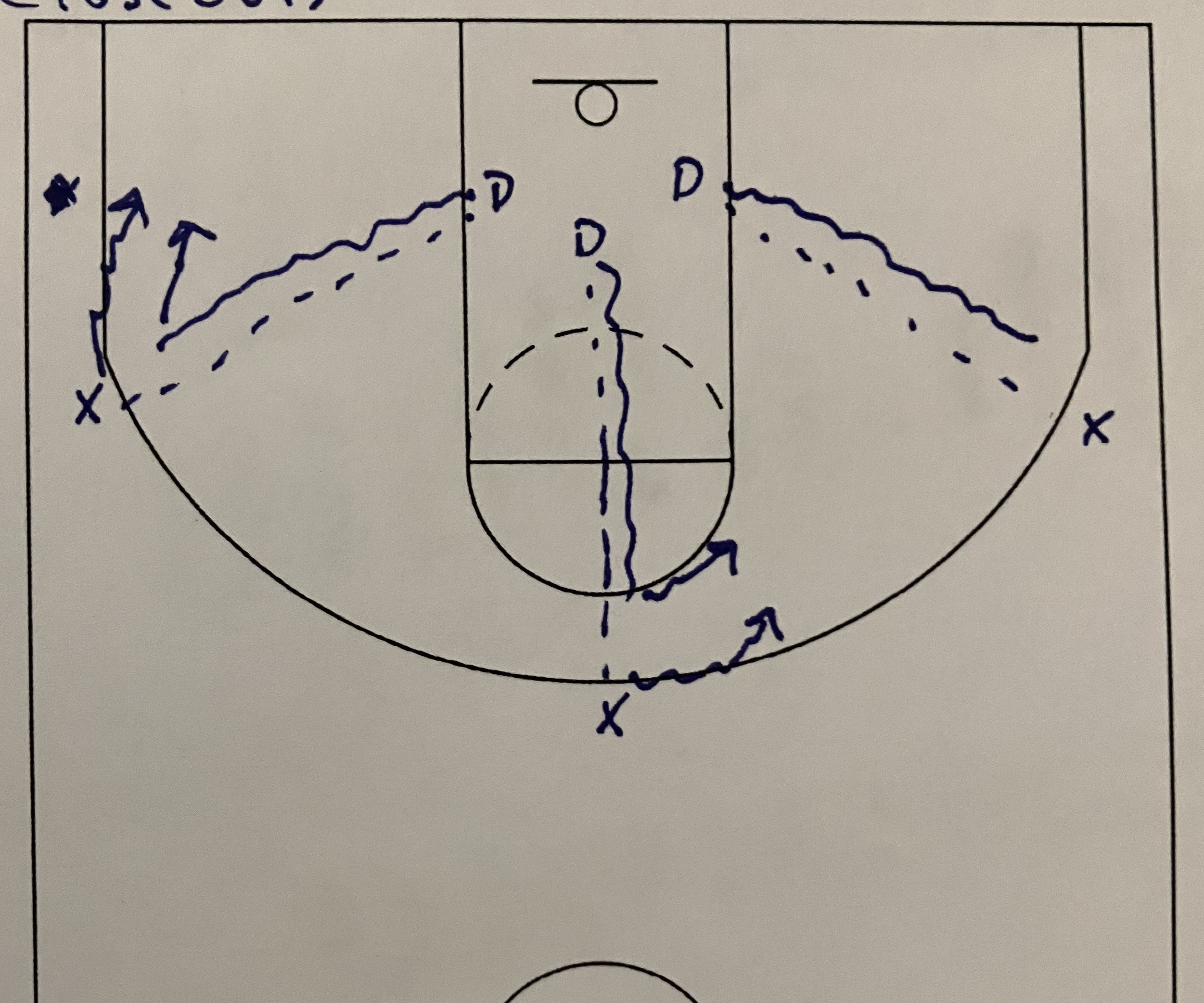
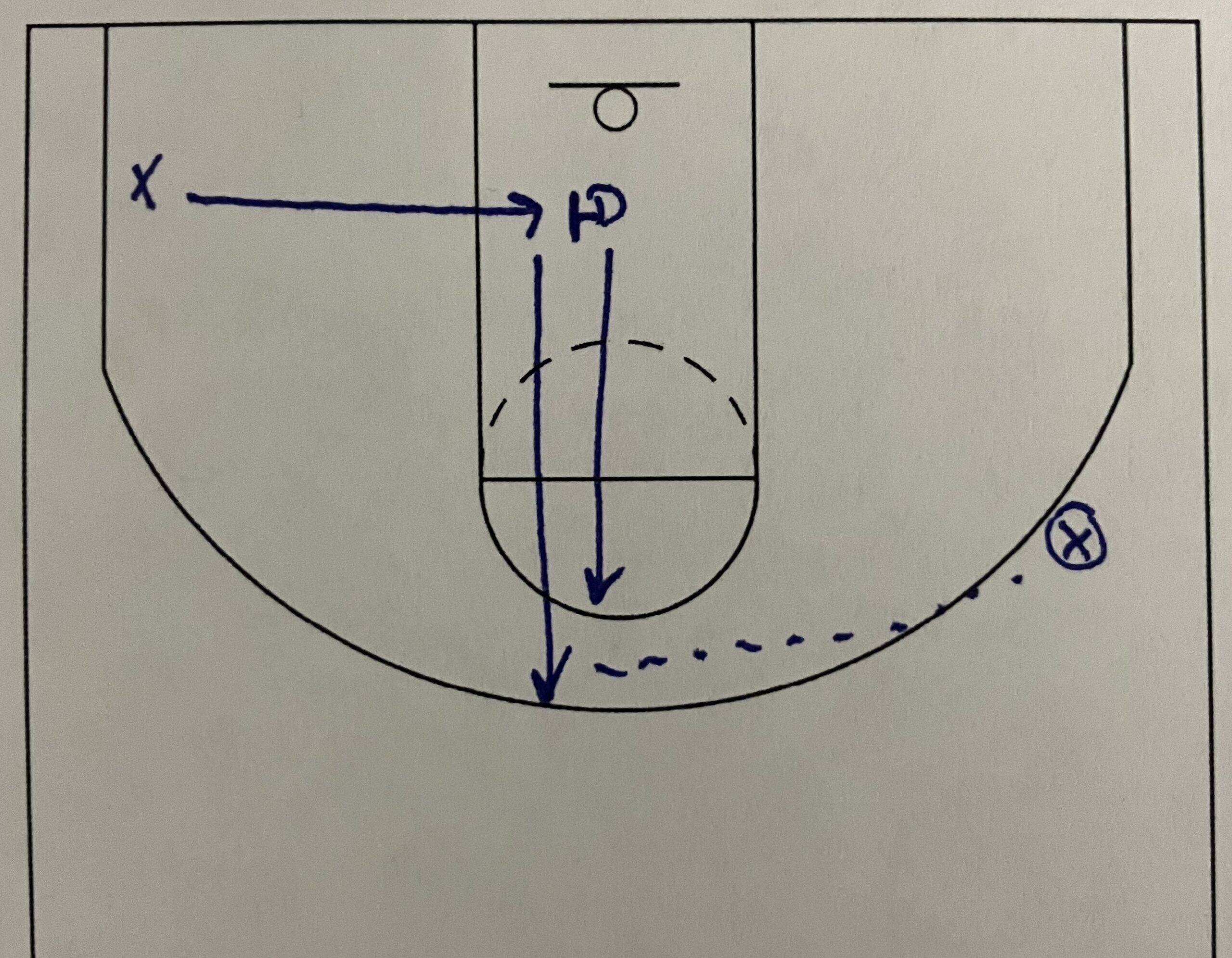
1 thought on “Man Press Defense- Run and Jump”